Debbie Young's Blog, page 40
August 25, 2016
Counter Spy in the New-Style Village Shop
 The new name for the Hawkesbury village shop since it passed into community ownership
The new name for the Hawkesbury village shop since it passed into community ownershipThis post about my new role as a volunteer in our community-owned village shop first appeared in the Hawkesbury Parish News (August 2016)
A few days ago, I entered the village shop with some trepidation for my first ever shift in our new community-owned shop.
I am not sure how I got to be this old without ever having worked in a shop before. The closest I’ve come was is during a very brief career as a waitress in a York tea-shop when I was a student.
After just two Saturdays, I retired, defeated by the need to manoeuvre a cake-laden tea-trolley laden up and down steps between three different rooms in the tea-shop. Any tips I earned were left out of pity rather than gratitude, while the waitresses for whom this was a full-time job boasted they’d collected enough to buy fur coats.
 Rush hour at the new Hawkesbury Stores
Rush hour at the new Hawkesbury StoresFortunately, my first shift at the village shop was less traumatic. Despite there being much to learn, I couldn’t have had a more positive and encouraging teacher (thanks, Kath!), nor a cheerier clientele, all of whom were full of praise for our new-style stores.
Even so, it’ll take a few more shifts before I can stand behind the counter without feeling like a pupil who has sneaked in to the staff room while the teachers weren’t looking.
 “God bless these stores and all who shop in her” – the vicar does his first ever shop blessing, after the Hawkesbury Stores had been officially opened by Hawkesbury-born Rio Paralympian James Blackwell (in red tracksuit top)
“God bless these stores and all who shop in her” – the vicar does his first ever shop blessing, after the Hawkesbury Stores had been officially opened by Hawkesbury-born Rio Paralympian James Blackwell (in red tracksuit top)Like to know more about the Hawkesbury Stores? Visit its website here: www. hawkesbury-stores.co.uk
Whether or not you live near enough to shop there, you can show your support by liking its Facebook page here.
FURTHER READING
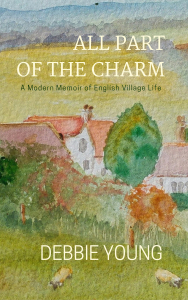 A collection of my columns for the Hawkesbury Parish News 2010-2016 is now available to buy in paperback or as an ebook. It includes as bonus material some essays I wrote when I first moved to the village over 25 years ago.
A collection of my columns for the Hawkesbury Parish News 2010-2016 is now available to buy in paperback or as an ebook. It includes as bonus material some essays I wrote when I first moved to the village over 25 years ago.
Naturally, the paperback is for sale in the Hawkesbury Stores, but you can also order it from any bookshop (just quote ISBN 978-1911223023) or online.
“Totally charming… just makes you want to pack up and move there straight away” says Spabbygirl’s review on Amazon UK.
Filed under: Personal life Tagged: Hawkesbury Stores, Hawkesbury Upton, village life, village shop

August 16, 2016
What I Learned About Television Broadcasting from My Interview on That’s Oxfordshire TV
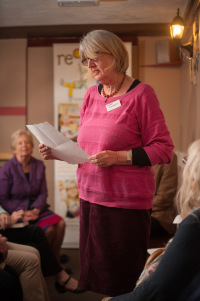 My author friend Mari Howard reading her poetry at the first Hawkesbury Upton Literature Festival last year
My author friend Mari Howard reading her poetry at the first Hawkesbury Upton Literature Festival last yearPicture by Clint Randall http://www.pixelprphotography.co.uk
A post about my recent appearance on That’s Oxfordshire TV
Just before I went away for my summer holidays, I had the pleasure of taking part in a television chat show for a local cable TV station That’s Oxfordshire, thanks to the kind invitation of my author friend Clare Weiner, who writes as Mari Howard.
I’ve known Clare/Mari for several years, we read and enjoy each other’s books, and she’s been a staunch supporter of the Hawkesbury Upton Literature Festival, where she’s spoken on panels and read from her novels and her poetry. We were therefore able to talk on the same wavelength (if you’ll excuse the broadcasting pun) when interviewed by presenter Eve Ahmed.
Eve was keen to know all about writing, (self-)publishing and book marketing, and with well-targetted questions enabled us to cover a lot of ground within two fifteen-minutes slots without ever feeling rushed – a real art.
What I Learned About TV Broadcasting
This wasn’t the first time I’d appeared on television, having previously featured on BBC’s Countryfile, interviewed by the very lovely John Craven, but that was done strolling outside together in the grounds of Westonbirt House. I hadn’t done the classic sofa interview before, though, so it was fascinating to see what goes on behind the scenes of TV studio broadcasting e.g. getting miked up, discovering that the presenter operates the autocue for her opening comments with a concealed foot pedal so she can go at her own pace, and noticing that the coffee cups hospitably placed on the table before us didn’t contain coffee, but spare microphone clips!
Other useful tips I picked up from the experience:
I have the knees for radio (to be fair, I think the camera angle made them look disproportionately large!)
It’s better to wear outfits that cover your arms and legs
I should look up more when speaking (it’s a bit shifty to be looking down so much)
If you try, you can fit a lot of books on a coffee table and sofa (neat product placement opportunities there!)
Those semi-circular sofas that always seems to feature on such shows are more comfortable than they look
The stills that YouTube selects to illustrate each video are not what one would choose if asked!
But despite the inevitable cringes that accompany seeing yourself on video, I hugely enjoyed the whole thing, and would love to do more. I knew I already loved doing radio (I’m a regular guest on BBC Radio Gloucestershire’s monthly Book Club hosted by presenter Dominic Cotter), which has the saving grace of invisibility, and was pleased to know that I was no more nervous for TV. What a show-off I must be! (I blam youngest child syndrome!)
Many thanks to the highly professional and polished Eve Ahmed for conducting the interview and to Clare/Mari for inviting me to join her.
Now Watch the Interview
Both episodes are now available to view on YouTube, so if you’d like to see them, just click these links below. Each one is just 15 minutes long.
Filed under: Self-publishing, Writing Tagged: book talk, broadcasting, Clare Weiner, Eve Ahmed, interviews, Mari Howard, television, That's Oxfordshire

August 8, 2016
Spot the Tourist
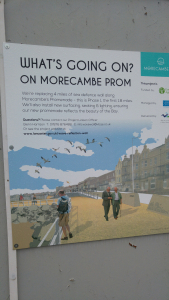 A post about being put in my place on holiday
A post about being put in my place on holiday
Whenever I am on holiday, I love people-watching, observing others and eavesdropping on their conversations. Ok, I confess, I do this all year round wherever I am, and it’s a key source of ideas and inspiration for my stories. But it’s not just a storyteller’s habit – my daughter (13) does it too, and we often exchange knowing smiles when we’ve both tuned in to a particular gem.
Popping into the RNLI Lifeboat shop on the Morecambe seafront, we enjoyed hearing an upbeat conversation between the two elderly volunteers agreeing that you are never too old to look forward to the future, citing a friend of theirs who I think must have been in her nineties. I was also enjoying their lovely Lancashire accent, channelling George Formby without the ukelele.
Then, when I took a tin of travel sweets to the till and asked to pay, they went into raptures about my own pronunciation, which is essentially Thames Estuary softened by long absence.
“Eeh, say that again, would you? Just listen to that accent!” said the first lady, beckoning to her companion.
“Eeh, doesn’t she sound like our friend?” said the second lady. “Go on, say something, love. Just say anything. We love hearing your accent.”
And there was me thinking they were the ones with the accent. Wrong-footed, I was taken back to my childhood, when for a year our whole family lived in the USA, first near Philadelphia and then near Los Angeles. In both places we were constantly being asked to speak, in much the same way as you might cajole a clever pet dog to shake paws. In the next breath they’d ask us whether we knew the Beatles (there, that dates me) or whether we’d met the Queen, then try not to show surprise or disappointment when we said no.
The RNLI ladies’ expectations were not so far-fetched. They asked only whether I came from the same place as their friend – Welwyn. Again I had to disappoint them. (Though later I wondered whether she’d actually said Welling but dropped the final g – in which case my answer would have been a more pleasing “very nearly” as it neighbours my native Sidcup.)
We then fell into a cheery conversation about holidays, and we eventually left the shop with our spirits lifted far beyond the value of the money we’d spent there.
Now whenever I take a sweet from the tin on the dashboard of our camper van, I can’t help but smile at the memory of that encounter – an additional positive association for these distinctive tins of travel sweets, which I’d previously always connected with my grandfather. But that’s another story…
Filed under: Family, Personal life, Travel, Writing Tagged: English accents, George Formby, Lancashire, Morecambe, tourism, tourists, Travel, travel sweets

July 29, 2016
A Morning in Morecambe
A post celebrating the English seaside town of Morecambe, Lancashire
Even the great Eric Morecambe, this small town’s most famous son, commemorated on the seafront by a statue, couldn’t bring sunshine to Morecambe Bay the day we broke our journey there on the way to Scotland.
But his cheerful spirit abounded at the local branch of family pub chain Wetherspoons, named The Eric Bartholomew (his birth name) in his honour, where we breakfasted. Cheerful young bar staff called all the customers by terms of endearment that would have sounded more at home from the mouths of the largely middle-aged-to-elderly clientele, who were already enjoying their hospitality with everything from tea and toast to pints of lager and bottles of wine. One old man had nearly finished a bottle of wine at elevenses time. I guess the good news was that he was drinking it indoors out of a glass instead of a brown paper bag, while chatting companionably with the morning coffee brigade.
Despite the grey weather, it was good to see that this classic seaside town was looking considerably less seedy and neglected than on previous visits, with whole rows of terraced B&Bs along the seafront sporting “No Vacancies” signs.There is also a major construction project going on to revitalise the promenade.
It’s being financed by locally rather than by the EU, I noticed. I loved the decorative pavement edging inspired by local fossils.

The town has a proud and creative spirit, as shown by the original artworks nestling among vibrant-hued corporation planting. Seabird sculptures are everywhere, and a joyful statue of a mother twirling a child by the hands is the last you see of the town heading north along the coast road.These sit comfortably alongside more traditional landmarks such as this cute clock tower that looked like something straight out of Trumpton.
They’ve even managed to annexe the Lake District by placing a striking sculpture on the seafront indicating the hills theoretically visible from Morecambe. Lesser towns would have made do with a map.
Even though the rain obscured every one of the peaks that morning, the sculpture added to our positive experience of Morecambe.
Despite these highlights, it’s still impossible to visit this place without remembering the tragedy of the Chinese immigrant workers who lost their lives gathering cockles here a few years ago. The warning signs on the prom might seem laughably over the top to anyone who wasn’t aware of the serious dangers lurking in these treacherous shifting flat sands.
This region also inspired the multiple-award-winning, highly atmospheric novel The Loney by Andrew Michael Hurley, which I reviewed for Vine Leaves Literary Journal here.
Wherever you are holidaying this summer, respect the water and the hills, stay safe, and have fun, and I hope someone like Eric Morecambe brings you sunshine.
Filed under: Travel Tagged: Lake District, Morecambe, Morecambe and Wise

July 25, 2016
I Swear I Didn’t Mean It… (with a Free New Short Story!)
A quick post to share the article I’ve just written for the ALLi Author Advice Centre on the use of bad language in fiction
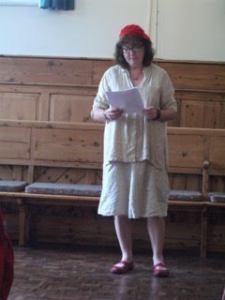 Already committed… (Thanks to fellow author Jacci Gooding for the photo)
Already committed… (Thanks to fellow author Jacci Gooding for the photo)Do you give a damn whether there is swearing in the stories you read?
Personally, I’m not keen on hearing the same bad language over and over again supposedly for the sake of realism, whether on television, in films or in books, and I don’t use it much either.
In fact, I’d always thought the language in my own fiction was pretty blameless. That is, until I started reading a new story, as yet unpublished, in the Quaker Meeting House as part of the Evesham Festival of Words last month. Eager to give a brand new, unpublished story, Drunk in Charge, an airing and get some feedback, I hadn’t really thought through the implications of the setting before I got there.
Today I’ve shared the experience over on the ALLi Authors Advice Centre blog, where every Monday is our “Opinion” day, on the basis that it’s good to start the week with a rousing debate. If you’d like to read my piece in full, you can hop over to the blog here.
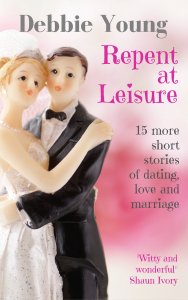 One of my works-in-progress, which will include the short story “Drunk in Charge”
One of my works-in-progress, which will include the short story “Drunk in Charge”Or if you prefer to cut to the chase, you can read Drunk in Charge here. A more polished version will appear in my next collection of short stories, Repent at Leisure, to be published, er, at my leisure… Join my mailing list here if you’d like me to let you know when it’s available, and you’ll also get a free download of Quick Change to read while you’re waiting.
Now back to writing the rest of the stories…
Filed under: Events, Reading, Writing Tagged: ALLi, Author Advice Centre, bad language, Drunk in Charge, Evesham, Festival of Words, Quaker Meeting House, Repent at Leisure, swearing

July 22, 2016
Old-fashioned Cameras vs the Smartphone – or Why Less is More with Holiday Snaps
In my column for the July/August edition of the Tetbury Advertiser, I ponder the dilemma of taking too many summer holiday snaps in the age of the smartphone and am nostalgic about the rarity value of photographs taken with the old-fashioned cameras of my childhood
 Possibly my favourite holiday snap of all time: Laura with my dad on the beach at Mousehole
Possibly my favourite holiday snap of all time: Laura with my dad on the beach at MouseholeLights – Camera – Inaction
Passport – check. Tickets – check. Currency – check. Camera – er, no, actually. These days, I don’t even possess a camera, having transferred my photographic loyalties to my smartphone, for several reasons. Firstly, it means one thing less to carry. Secondly, it means one thing less to remember. (Always good news once you get to a certain age.) Thirdly, as if by magic, the photos from my smartphone are automatically uploaded to cloud storage, so I don’t even have to do anything to get them onto my computer.
The downside is that I now have a vast number of photos up there in the ether that I’ve completely lost track of. Even so, I still snap everything in sight when I’m on holiday, because it’s free and easy to do.
Scarcity Makes the Heart Grow Fonder
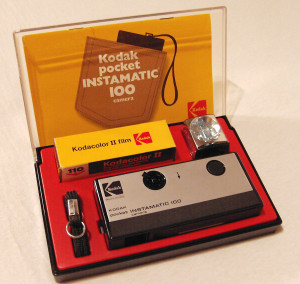 (Photo by Carsten Corleis – Own Work. Photographed with a ‘Praktica Luxmedia 4008’ digital camera, CC BY-SA 3.0)
(Photo by Carsten Corleis – Own Work. Photographed with a ‘Praktica Luxmedia 4008’ digital camera, CC BY-SA 3.0)What a change from my childhood, when I had one of those new-fangled Instamatic cameras. Remember them? The film came in an easy-to-load drop-in cartridge, so you no longer had to feed it into a spool inside your camera in a darkened room. It was the most democratising development (if you’ll excuse the pun) since the introduction of the Box Brownie, making photography more accessible and affordable for the untechnical masses. If you needed a flash, you popped a little cube on the top of the camera containing four bulbs, burning your fingers when you removed it after use. Well, one must suffer for art.
Latter-Day Rationing
The only big decisions were whether to choose film for slides or for prints – slides were a big thing in those days, and I had a small battery-lit box on which to view them – and whether to opt for twelve pictures, twenty-four, or, if you were feeling flush, because processing costs were in proportion to the number of pictures, an extravagant thirty-six picture film. On a pocket-money budget, I’d eke out one film for a holiday, rationing myself to a picture or two a day. Occasionally I’d have spare pictures to take when I got home. Films came with use-by dates, after which they’d start to degrade, so sometimes there’d be a mad rush to take the last few shots before a film expired.
The Unavoidable Lens of Digital Cameras
To my daughter, such limitations seem laughably quaint, but I wouldn’t mind returning to that style of photography. These days, it’s too easy to end up viewing half your holiday through your smartphone screen, self-imposing tunnel vision, and missing out on the third dimension.
Pictures Are Better in Your Head
So this summer, while I’ll still be taking my smartphone on holiday to send texts instead of postcards (sob! how I mourn for that endangered species!), I’ll be making a conscious effort not to spend so much time snapping holiday shots. After all, just as the pictures on the radio are better than on TV, the memories stored in your head will always be superior to your holiday snaps.
Wherever you’re spending your summer holiday this year, I wish you a wonderful three-dimensional time.

If this post has whetted your appetite for more on the theme of summer holidays, you might enjoy:
The Role of the Hill in Children’s Summer Holidays – one of the most popular posts ever on this blog…
Flight of Fancy – a light-hearted cautionary anecdote about the perils of flying alone
What Not To Discover on On Your Holidays – a mystery worthy of Jessica Fletcher
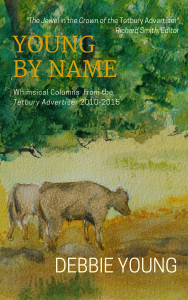 Collected columns from my first six years of writing for the Tetbury Advertiser
Collected columns from my first six years of writing for the Tetbury AdvertiserIf you’d like to read more of my monthly “Young By Name” columns for the Tetbury Advertiser, you can buy them in a single volume as an ebook (£2.99) or in paperback (£6.99) – dare I suggest these short, light-hearted whimsical pieces might make good holiday reading?
Order Young by Name from your local bookshop quoting ISBN 978-1911223030 or .
(IMHO, it’s worth buying in paperback to get the beautiful watercolour cover image provided by my talented father!)
Filed under: Family, Personal life, Travel, Writing Tagged: camera, holiday photographs, instamatic, Kodak, nostalgia, Photography, summer holiday, Tetbury Advertiser

July 21, 2016
Sombre for the Somme Centenary
A post about the Somme centenary service in Hawkesbury Upton and Simon Bendry’s new book commemorating Hawkesbury’s war dead and war veterans
 The Somerset Monument, commemorating a local officer in the Napoleonic Wars, towers above my village, Hawkesbury Upton
The Somerset Monument, commemorating a local officer in the Napoleonic Wars, towers above my village, Hawkesbury UptonSometimes looking around our village, nestling comfortably on the last of the Cotswolds before the landscape tumbles down into the Severn Vale, it’s easy to believe that this is a safe and privileged place, untouched by human conflict.
That is, until you notice the village war memorial, marked by a simple cross on the Plain, as our small village green is known. Surrounded by historic houses, the traditional pound, where stray livestock would be impounded for the collection, the war memorial is a daily reminder that during both World Wars many members of our community served their country in HM Armed Forces, a substantial number never to return. Some of these were lost while serving in the Somme.
How We Remembered Them
Each year on Remembrance Sunday, the local branch of the British Legion organises a respectful procession from the Village Hall, originally the Hospital Hall treating military casualties, on the Plain for a simple service around the war memorial, bringing all generations together. This gathered throng far exceeds the usual church attendees, and typically includes past, present and future officers from HM Forces, as well as descendants of those named on the memorial. Many of those surnames are still represented in our community.
Our Somme Remembrance Service
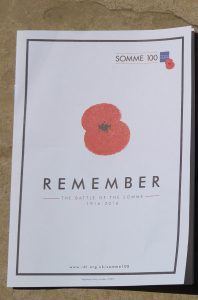 The service sheet used at our Somme Centenary remembrance service
The service sheet used at our Somme Centenary remembrance serviceOn Friday 1st July, we held an additional services at 7:30am, along with many other communities nationwide who marked the hundredth anniversary of the beginning of the Battle of the Somme. It included the three sharp blasts on a military whistle that marked the call to go “over the top” of the trenches to face gunfire from the enemy. where in the course of a long process over a million men tragically to lose their lives for no obvious gain.
In Hawkesbury Upton, our act of remembrance for the Somme included at least one high-ranking officer, one young servicemen currently on leave, and one new recruit eagerly awaiting his joining instructions. Their presence was a sobering reminder that the names on the monument represented real characters, much loved by their community, and that in times of war, not even our cosy little village would be a safe haven.
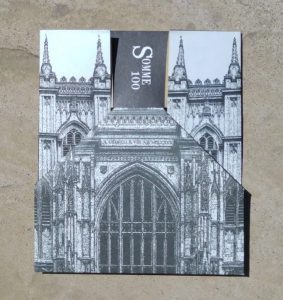 The invitation to the Westminster Abbey vigil, organised by Simon Bendry from Hawkesbury Upton
The invitation to the Westminster Abbey vigil, organised by Simon Bendry from Hawkesbury UptonNor is our village as remote or insignifcant as the outsider might assume from the national events, because, to the pride of our entire community, one young man from our village played a pivotal part in the national commemorations. Simon Bendry, who grew up in our community, went to school here, and whose parents live here still, was part of the small team that created and ran the all-night vigil the night before in Westminster Abbey, to be attended by the Queen to lead the national act of respect.
It was Simon’s idea that the vigil would link to a series of individuals who took part in the war, and that throughout the night their stories would be shared. You can listen to their accounts here.
Simon works as National Education Coordinator, First World War Centenary Battlefield Tours Programme, for the UCL Institute of Education.
New Commemorative Book of the War Memorial
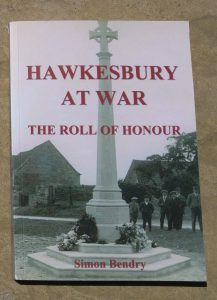 A labour of love by a Hawkesbury historian
A labour of love by a Hawkesbury historianThough Simon may have been far from the village as we paid our local tribute, I’m sure he will have had the Hawkesbury fallen in his thoughts, following the publication earlier this year of his moving personal tribute: a biography of each of those named on the Hawkesbury War Memorial plus those who served but survived. This meticulous labour of love was the result of 18 years research, something he had longed to do since passing the memorial each day on his way to and from school. The beautifully produced book, a huge asset in our growing library of local history books, is available to buy in the Hawkesbury Stores, Hawkesbury Upton Post Office and online.
Earlier Commemoration in 2014
The service and Simon’s book also brought back memories of another tribute made by our village drama club two years ago to mark the centenary of the outbreak of World War I. They created a revue which combined local materials such as letters from serving officers, with more well-known items. I have never seen a more moving piece of drama in the village children, including my daughter then aged 11, all dressed in black and holding poppies, silently and slowly fell, one by one, to the floor during a recital of John Macrae’s poem In Flanders Fields which includes the chilling line “We are the dead”.
Down here in our idyllic little village, a hundred miles from the nation’s capital, off the beaten track and off the national agenda, we shall remember them.

Filed under: Events, Personal life Tagged: First World War, Hawkesbury Upton, poetry, poppies, Remembrance Day, Simon Bendry, Somme 100, war poets, Westminster Abbey, World War I

July 20, 2016
How to Review Books, and Why You Should – Guest Post for “The Artist Unleashed”
 (Not Jessica, in case you’re wondering!)
(Not Jessica, in case you’re wondering!)Today my guest post about my philosophy of book reviewing features on the excellent Artist Unleashed blog, which is curated by the multi-talented Jessica Bell, author, poet, musician, publisher and book cover designer.
 Vine Leaves logp
Vine Leaves logpAs well as writing many works of fiction and poetry, Jessica is the founder and director of Vine Leaves Literary Journal, which celebrates the vignette – a short and ancient form of fiction that gets its name from being sufficiently succinct to fit on the back of a vine leaf. I’ve been proud to be part of the Vine Leaves team for a couple of years, editing its book blog, endearingly called Sampling the Wine. We review books by authors whose vignettes have been accepted for publication in Vine Leaves, and also, more recently, other literary fiction.
Here’s the opening paragraph of my post about reviews, ending with a link to read the rest of it on the Artist Unleashed blog – a site well worth exploring. Take the time to delve into its archives, and you’ll find all sorts of stimulating posts by other authors on topics related to books and writing.
As a reviewer for Vine Leaves Literary Journal and the Historical Novel Society, and an author of fiction and non-fiction, I have long believed that all writers ought not only to read widely, but also review the books they read.
It doesn’t matter whether or not they share their reviews in public, on retailers’ websites or social media, or on their own (book) blog. They don’t even have to write the reviews down. But it will help them grow as writers if they at least pause after reading one book to consider and digest what they’ve read, before moving on. READ MORE
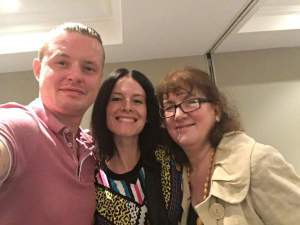 Sharing a speaker platform with Jessica Bell and Ben Galley at the Dublin Writers’ Conference last month
Sharing a speaker platform with Jessica Bell and Ben Galley at the Dublin Writers’ Conference last monthI am grateful to Jessica for the opportunities she has given me to work with her on her blogs, and for her friendship and moral support elsewhere too – we recently spoke on a panel together at the Dublin Writers’ Conference, and I also had a fabulous time a couple of years ago as a guest speaker at her excellent writers’ retreat on Ithaca, one of the most formative experiences of my writing career.
 Wonderful memories and much knowledge gained from the retreat organised by Jessica two years ago
Wonderful memories and much knowledge gained from the retreat organised by Jessica two years agoFinally, I’d like to recommend Jessica’s books – fiction, poetry and writing guides for other authors. Good starting points are her novel String Bridge, her extraordinary dystopian poem/short story in verse Muted, and her Nutshell series of writers’ guides – Polish Your Fiction lives on my desk! So if you’ve not already read any of her books, head over to her author website and browse her catalogue.
If you enjoyed this post, you might also like to read:
more about that Ithaca retreat here: A Summer of Extremes: From Ithaca to Inverness
a post about other reviewing work that I do on BBC Radio Gloucestershire’s Book Club
… and another about my role as book reviewer for Today’s Child magazine
Filed under: Reading, Writing Tagged: Artist Unleashed, book blog, book reviewer, book reviews, Jessica Bell, Reading, Vine Leaves, Writing

July 14, 2016
Creative Memory and Creative Amnesia and Why They Matter
 I’ve a memory like a kitchen colander (Photo: Morguefile.com)
I’ve a memory like a kitchen colander (Photo: Morguefile.com)Three times in the last couple of days I’ve been struck by a phenomenon that never fails to surprise me:
while blessed with total recall for insignificant events as far back as my childhood, I also have a prodigious power to forget things
A colleague from my last corporate job had a theory that our brains had a fixed capacity, and once they were full, the rest would just spill out over the edges and be lost. As working mums, we had a lot to remember, both at work and at home. We wished someone would invent a memory chip to expand our brains’ hard drives.
A Mixed Blessing for an Author
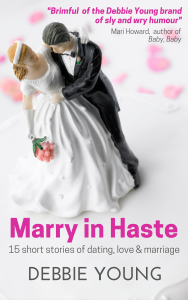 Now, that looks familiar…
Now, that looks familiar…In one respect, it’s a good thing for an author to have a good memory to provide plenty of raw material to inspire and inform creative writing. Many of my short stories are triggered by a phrase or scene recalled from decades ago.
The first story in Marry in Haste, for example, is the result of a conversation with colleague in my first decent office job. In between photocopying our faces for the informal gallery that adorned an office partition (well, it could have been worse), we were discussing boyfriends. She asserted that she couldn’t marry anyone who was not a vegan, immediately limiting her potential partners to a tiny minority of the population. That notion stayed with me for decades.
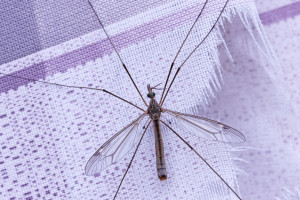 Sometimes it’s handy to have a memory as short-lived as a mayfly (Photo: Morguefile)
Sometimes it’s handy to have a memory as short-lived as a mayfly (Photo: Morguefile)But it’s also important for an author to be able to forget the precise words and even the shape of a story they’ve written. This selective amnesia is necessary for self-editing purposes. If you try to tweak a story that you know so well you can recite it, it’s very hard to spot errors and potential for improvement.
Hence the standard advice to aspiring writers to put your finished manuscript in a drawer for six weeks and come back to edit it fresh. Scientific research proves that if you leave it long enough to erode detailed recollection, you can edit the words as easily as if they’ve been written by someone else.
Three Times Unlucky
I’ve had striking evidence of this effect three times recently: twice regarding my own writing and once a writer friend’s.
 Great source of author networking opportunities – click the image for more info
Great source of author networking opportunities – click the image for more infoThe writer friend emailed me to pitch an idea for the ALLi Authors Advice Centre blog of which I’m Commissioning Editor. She said she’d messaged me last year about the idea, but she’d never written the proposed post and would I like to take her up on it now?
Normally, my first thought at times like this is mea culpa, assuming it was me who’s forgotten to act, but the post that she mentioned had stuck in my mind because it was a very interesting topic. A quick search revealed that I’d published the post last September, so she must have written it. Coming soon (when I can find the rest of the manuscript)
Coming soon (when I can find the rest of the manuscript)
I made her feel better when I revealed that only the previous day, I’d come across the draft of a story I’d written for my current work-in-progress collection, Repent at Leisure (sequel to Marry in Haste).
I tend to write my collections in bits and pieces over many months, till I’ve saved up enough stories on a single theme to fill a book. Not only had I forgotten I’d written the story, but I couldn’t remember the plot, and had to read to the end to find out what happened.
Maybe I have the equivalent of the Tailor of Gloucester‘s mice, who set to work in my study when I go to bed. No wonder my cat spends so much time sitting on the windowsill by my desk.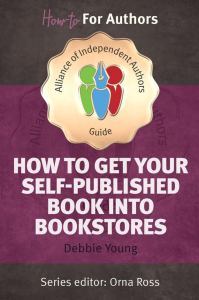 My current non-fiction work-in-progress is a commission from the Alliance of Independent Authors
My current non-fiction work-in-progress is a commission from the Alliance of Independent Authors
Last Friday, unable to find my handwritten manuscript of a final chapter for a new non-fiction book, I spent the morning tidying my study in the hope that it would turn up. It was nowhere to be seen, and I began to wonder whether I was suffering from false memory syndrome. Was my recollection of writing it just wish fulfillment?
Only when I opened the Word file of the nearly-finished manuscript did I discover that not only had I written it, but I’d also typed it in already. The reason I couldn’t find my handwritten draft was that it had departed my study in the recycling box, surplus to requirements once I’d typed it up.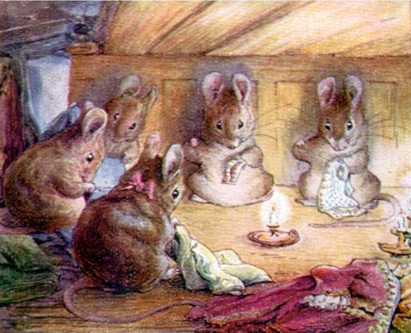 The Tailor of Gloucester’s anonymous assistants, who worked while he slept (from the eponymous Beatrix Potter book)
The Tailor of Gloucester’s anonymous assistants, who worked while he slept (from the eponymous Beatrix Potter book)
And the Moral Is…
So, rather neatly, there are three morals in here.
If you’re a writer, use that all-important cooling-off period to distance yourself from your story – you will edit it all the better once you can no longer recite the manuscript word for word.
Second, tidy your desk, because you never know what you might find.
Third, don’t worry too much if you forget the odd thing. It might lead to a pleasant surprise later. Provided you know the day of the week and the name of the Prime Minister, you’re good to go, though goodness knows, that is getting more challenging, the way the UK politics are heading.
And what of my vegan friend? Eventually she weakened and married a lovely vegetarian. I do so love a happy ending.
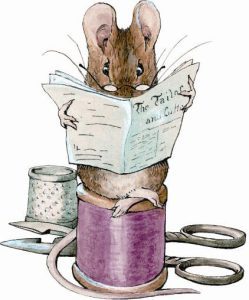
For a complete list of my short story collections, click here.
To find out more about my non-fiction books for authors, click here.
To be one of the first to know when I publish a new book, sign up to my mailing list here. (You’ll also receive a free ebook download to keep you going in the meantime!)
Filed under: writing Tagged: Alliance of Independent Authors, amnesia, forgetful, Marry in Haste, memory, remember, Repent at Leisure, Tailor of Gloucester

July 13, 2016
Straight from the Lexicographer’s Mouth: An Enjoyable Talk about the OED (Oxford English Dictionary)
A report about a fascinating talk about the Oxford English Dictionary by Edmund Weiner
 The paperback edition is just the tip of the iceberg with a mere 120K words and 1k pages
The paperback edition is just the tip of the iceberg with a mere 120K words and 1k pagesAnyone who loves words would have been as rapt as we were at the Oxford Authors’ Alliance last night, when Edmund Weiner, Deputy Chief Editor of the Oxford English Dictionary, came to talk to us about his work preparing version 2.0 of the OED. This mammoth task employs sixty people, and though it began in 1993, they’re still only 30% of the way through the task. They are effectively detectives, examining everything ever written in English to come up with comprehensive definitions of how every word has been used through the ages.
Our meeting place in the heart of Oxford couldn’t have been more apt – in the book-lined basement (affectionately referred to as “the Bunker”) of the maverick Albion Beatnik Bookshop. The walls are painted with words, and the ceiling is papered in printed pages of books, so we were totally immersed. I am kicking myself now for not taking photos, but the talk was so absorbing that I completely forgot.
A DYNAMIC DUO OF WORDSMITHS
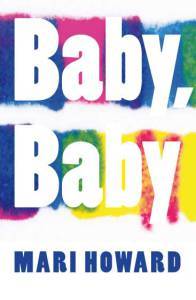 The first in Mari Howard’s compelling and intelligent series of contemporary novels about fertility science and medical ethics
The first in Mari Howard’s compelling and intelligent series of contemporary novels about fertility science and medical ethicsWe’d had the good fortune to be introduced to Edmund by his wife Clare, who writes novels under the pen-name Mari Howard. She is a member of both the Oxford Authors Alliance and the global Alliance of Independent Authors (of whose Self-publishing Advice blog I’m Commissioning Editor). She’s also a regular Hawkesbury Upton Literature Festival author, where she has given readings of both her prose and poetry and taken part in lively panel discussions. Edmund has always come along to support her and enjoy the Festival, and it’s been a pleasure to have him open up now about his own important work with the basic components of the author’s craft: words.
DEFINING EDMUND WEINER
Edmund is what’s known as a historical lexicographer, defining words by tracing their origins and history and cataloging their changing use as time goes by, because, as he pointed out, our language is constantly evolving. This fact makes him reassuringly dismissive of any notions of rights and wrongs in its use.
A CUNNING ONLINE PLAN
Of course, in the early days of dictionaries (with which most of us are chiefly familiar from the episode of Blackadder III in which Baldrick uses Samuel Johnson‘s only draft of his first dictionary to light the fire) everything was done by hand and on paper. These days, records are all online, which provides an endless canvas for our endlessly expanding language: 600,000 words and counting, and no word is ever removed.
AND FINALLY… The Fascinating Evolution of the Word “Toilet”
 No, not THAT sort of toilet water!
No, not THAT sort of toilet water!Apparently anyone with a library card may access the OED online free of charge (another great reason to support your local public library), but there are also some public pages freely available that, now I’ve discovered them, I expect to prove highly addictive. One of the highlights of Edmund’s fascinating talk last night was when he read to us his essay on the descent of the word “toilet” – particularly helpful to me as I recently struggled to answer my daughter’s question as to why anyone would want to splash “toilet water” on themselves.
Here’s a link to his must-read article for you to enjoy:
Recent Updates to the OED: The definition of “toilet”
I’m hoping we’ll hear more from Edmund Weiner about our fascinating language at a future Hawkesbury Upton Literature Festival – watch this space!
With thanks to Edmund Weiner, Clare Weiner/Mari Howard, the Albion Beatnik Bookshop, and Oxford Authors Alliance organiser Lynne Pardoe, who, by the way, has just launched her second novel in her series about social work, Abandoned by My Mum, now available as an ebook via Amazon for just £2.25).
Filed under: writing Tagged: Alliance of Independent Authors, author talks, Clare Weiner, Edmund Weiner, Hawkesbury Upton Literature Festival, lexicography, Lynne Pardoe, Mari Howard, Oxford English Dictionary, self-publishing, words




